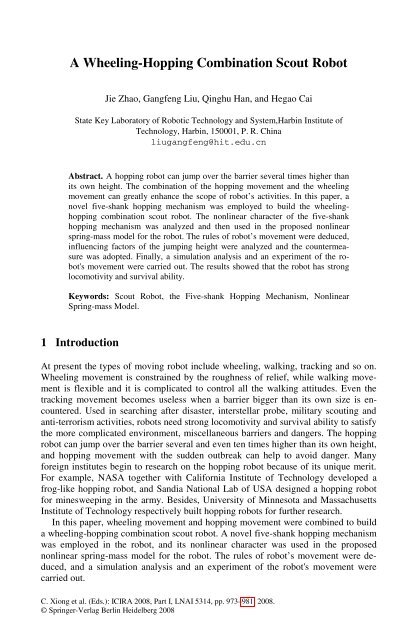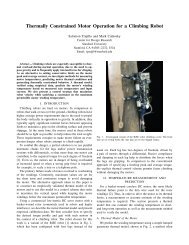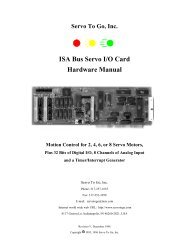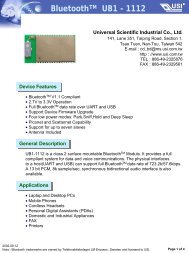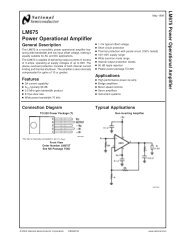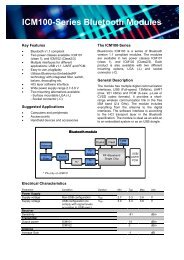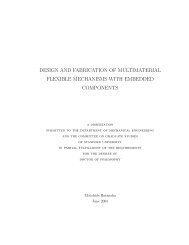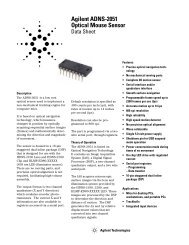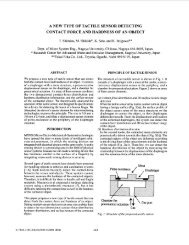A Wheeling-Hopping Combination Scout Robot
A Wheeling-Hopping Combination Scout Robot
A Wheeling-Hopping Combination Scout Robot
You also want an ePaper? Increase the reach of your titles
YUMPU automatically turns print PDFs into web optimized ePapers that Google loves.
974 J. Zhao et al.2 Brief Account of the <strong>Wheeling</strong>-<strong>Hopping</strong> <strong>Combination</strong> <strong>Robot</strong>and Design of the <strong>Hopping</strong> MechanismMechanical system of the wheeling-hopping combination scout robot is composedof two-wheel driving assembly and a hopping assembly. The robot can be driventhrough flat terrain to the destination by the wheeling assembly. When facing barrieror ditch, the robot manipulated by the hopping mechanism can jump over theobstacle.The wheel driving assembly of the robot has two independent drive wheels. Andthe structure of the hopping assembly is shown in Fig 1.1-Gear motor 2-Partial gear drive 3-Ratchet-and-pawl 4-One-way bearing5-Releasing reel 6-Five-shank hopping mechanism 7-Regulating reel 8-All-gear drive9-One-way bearing 10-Ratchet-and-pawlFig. 1. Structure of the hopping mechanismThe hopping mechanism is composed of gear motor 1, energy-releasing mechanism(including 2, 3, 4, 5), five-shank hopping mechanism 6 and energy-regulatingmechanism (including 7, 8, 9, 10). When the gear motor is in positive revolutions,one-way bearing 9 and gear 8 are driven to regulate the reel 7, and then the extensionof the spring, thus the energy storage is changed. When the gear motor is in negativerevolutions, one-way bearing 4 and partial gear 2 are driven to regulate the reel 5, andthen fine-tune the extension of the spring, or release the string. Then the five-shankhopping mechanism exerts the force on the ground and the robot jumps up. Ratchetand-pawl3 and 10 lock the energy-releasing mechanism and energy-regulatingmechanism separately at any position. The energy-regulating mechanism can rotatecontinuously to regulate the energy storage in a wide range. And the energy- releasingmechanism can easily release the spring to get the robot jumping. The robot has asmall figure of φ 110 ×150 mm , and it weights 1.12kg.
A <strong>Wheeling</strong>-<strong>Hopping</strong> <strong>Combination</strong> <strong>Scout</strong> <strong>Robot</strong> 9753 Analysis of the Five-Shank <strong>Hopping</strong> MechanismThe hopping mechanism is the key part of the scout robot. The performance of sixshankmechanism is analyzed in [3], and it was pointed out that the six-shank mechanismhelped to lower the requirement for the single spring and avoid the spring’sbuckling. Also, the non-linear relationship between spring’s force and deformationcan be favorable to prevent robot from jumping ahead of time. In this paper, a fiveshankmechanism is used to build the hopping robot, as Fig 2 showed.Fig. 2. Schematic diagram of the five-shank mechanismThe mechanism expands in direction Y. According to the principle of virtual work,the relation between acting force and deformation is F ⋅ dy = F ⋅ dx . Associatinggeometrical relationship of the five-shank mechanism, equations set can be derived asfollows:$2− k ( x − L 0 ) ⋅ ( y ⋅ c − c )! F y =,!xa x⋅ c − ( y − c )( − )! 22 2!2 x 22# L 2 = ( ) + ( y − c ) ,(1)! 2!2 x a 2! c = L 1 − ( − ) .!2 2!"Where k is the elastic coefficient of spring, 0 L is the original length of spring, andc is intermediate variable. When the real parameter of the robot was substituted, therelation between acting force and deformation of the five-shank mechanism in directionY is shown in Fig 3.It was found that the relation between acting force and deformation of the fiveshankmechanism is similar to that of the six-shank mechanism derived in [3]. But theformer has more simple structure, and can be easily operated with only one DOF.yx
976 J. Zhao et al.Fig. 3. F y -Y curve of the five-shank mechanismThus in this paper, the five-shank mechanism is adopted, and the relation between itsacting force and deformation is simplified by curve fitting method as*F y= Ky (1 −4aIn it, K , a and b are the parameters of the fitting curve. K = 5 , b = 25, a = 42. 5 weregot when it was set as k = , L = 30, L = 40, L 45 .b2− y5 0 1 2 =Assume that the length of the five-shank mechanism in direction Y is y 0 when thespring has no deformation. According to Hooke’s law, the equivalent elastic coefficientof the non-linear spring produced by the five-shank mechanism is*2( y )0).(2)K( y)= Fy − y . (3)4 Analysis on the Dynamic Model of the <strong>Robot</strong>In order to get the jumping performance of the five-shank mechanism, it is necessaryto establish the dynamic model of the robot. At present the jumping model can bedivided into two kinds: spring-single mass continuous jumping model and springdoublemass intermittent jumping model. The former refills the energy of jumpingand adjusts the robot’s attitudes dynamically, and then goes on with the next jumpafter landing. So the continuous equation of motion can be set up for this model. Butusing this model, it is difficult for the robot to balance in quiescent condition. Also,the horizontal distance is limited because of the front rake which is hard to control, asa result the robot is always assumed to be vertical before jumping. The latter has twomass connected by a spring. The bottom mass balances and stabilizes the whole robot.After landing the robot refills energy of jumping and adjusts its attitudes according tothe circumstance, and gets ready for the next jump. This model is more practical forthe robot mentioned above.
A <strong>Wheeling</strong>-<strong>Hopping</strong> <strong>Combination</strong> <strong>Scout</strong> <strong>Robot</strong> 977The wheeling-hopping combination scout robot built in this paper stores energyfrom the extension of spring driven by the motor, which obviously belongs to intermittentjumping model. Meanwhile, the upper part of the robot is much heavier thanthe supporting leg of the five-shank mechanism, so single mass jumping model actsmore accurately for the robot. Moreover, three-point supporting composed of twowheeldriving assembly and the supporting leg balances the robot in quiescent condition,and the front rake can be adjusted by the three-point supporting to get enoughhorizontal distance. Considering all the factors above, a nonlinear spring-single massintermittent jumping model (see Fig 4) is established for the robot.Fig. 4. Jumping model of the robotr is the original length of non-linear spring, and ϕ is the front rake of robot. Thenthe five-shank mechanism is equivalent to the non-linear spring whose elastic coefficientis K (r), just as expression (3). Some processes and transients which are importantto jumping performance will be analyzed.4.1 Process on the GroundAssume that the point in which the potential energy is zero lies on the ground, thenthe kinetic energy and potential energy of the robot in the process on the ground areSo the Lagrange's equation is2 2( r!+ ( rϕ!) ),$ 1! K = M2!# V1= Mgr sin ϕ ,! 1! V2= K ( r)0" 2( r − r )2.2 21( r!+ ( rϕ!) ) − Mgr sin − K ( r)( r − r ) .1 20L = Mϕ22Substitute it into the second Lagrange's equationd * ∂L' ∂L( %− = 0.dt ) ∂x!i & ∂x i(4)
978 J. Zhao et al.After simplification, differential motion equations of the robot are$2M ⋅!!r − M ⋅ r ! ϕ + Mg sinϕ− K ( r)!# 2d( Mr ! ϕ)! + Mgr cosϕ= 0." dt( r − r)0= 0,With the consideration of the fact that the inertial rotation hardly functions on themovement because of the attitude adjusting, it is supposed that the robot neglects itsinertial rotation and the ϕ is a constant. So the equation (5) can be simplified intoM ⋅ r!! + Mg sin ϕ + K ( r )( r − r0 ) = 0.If ω 2 = K ( r ) M , the initial condition is r ( 0) = r0( r 0 is the original length of nonlinearspring), r! ( 0) = 0. After the differential equation is solved, expression of the robot’smotion during the process on the ground is* K ( r ) L 0 g sin ϕ 'r ( t ) = (− % sin ( ω t ) + r0cos ( ω t ).(6)) ω M ω &(5)4.2 Jumping TransientAssume that the robot doesn’t jump beforehand, the robot in jumping transient satisfiesthe criteriar ( t′ ) = r0, r! ( t′ ) > 0.A function is introducedr*( r − r ) dr − Mg ( r * −r) sin ϕ .Θ ( r*,r0, ϕ , M , K ) =+K ( r ) 00r0In it r * − r0is the deformation of non-linear spring, and ϕ is the front rake of therobot.WhenF y = Mg sin ϕ , in Fig 3 there are two corresponding points ( F y , r 1 )F y, and r 1 < r2. When r* ∈ ( r 1 , r 2 ), the five-shank mechanism can offer lar-and ( ) , r 2ger force than the weight of the robot, so the jumping criteria is$ Θ(r*,r0, ϕ,M , K ) > 0,#" r1< r*< r2.If viscous damper and friction are ignored, the energy conservation equation isr ∗+r01K ( r ) 0022( r − r ) dr = M ( v *) + Mg ( r * − r ) sin ϕ .In it, v * is the initial off-ground velocity, and r * is the length of the five-shankmechanism in Y direction when off-ground4.3 Aerial ProcessAfter jumping over, the robot is in parabolic motion under the effect of its ownweight, so the equation of motion for the robot is(7)
A <strong>Wheeling</strong>-<strong>Hopping</strong> <strong>Combination</strong> <strong>Scout</strong> <strong>Robot</strong> 979$ ∗ 1 2! Y ( t)= v t sinϕ− gt + r0sinϕ,#2! ∗" Z ( t)= v t cosϕ.(8)4.4 Jumping HeightUnder the condition that the efficiency is ignored, the robot can move to the highestpoint when all its elastic potential energy turns into gravitational potential energy. ItsatisfiesMg2( H r *) = K ( r )( r − r ) dr − M ( v * cos ϕ ) .maxr ∗−+So the maximum jumping height of the robot is:r0012(9)Hmax1 r ∗20= K ( r )Mg +r012 g( r − r ) dr − ( v * cos ϕ ) + r * .(10)The maximum jumping height H is the most important parameter of the wheelinghoppingcombination scout robot. According to expression (10), it closely relates tomaxthe initial off-ground velocity v * , the length of the five-shank mechanism in Y directionr * , and the front rake of robot ϕ .The front rake ϕ is determined by the comprehensive requirements for both jumpingheight and horizontal distance. According to jumping criteria of expression (7), itis necessary to make r * be close to r 2in order to get a higher jumping height. At thesame time, an initial velocity is needed to avoid the robot jumping beforehand. So anelastic buffer set in the five-shank mechanism with the thickness of r2 − r3is designedto absorb the deformation from r 2to r 3in direction Y. And then, just as thefive-shank mechanism gets r 3, the robot gains the largest Fmaxto jump over. Thusthere are larger impact force and jumping velocity for the robot to get an ideal height.5 Simulation Analysis and Jumping Experiment of the <strong>Robot</strong>A simulation analysis is carried out with the software ADAMS to validate the jumpingperformance of the robot. The parameters of the spring are as follows: the elasticcoefficient of spring k = 5N/mm , the damping of the spring C = 0.05Ns/mm, the0original length of the spring L 0 = 30mm , and the front rake of robotϕ= 60 . Thenthe height-time curve of robot’s barycenter is shown in Fig 5.From Fig 5 we can see that the maximum jumping height of the robot is about150mm. From equation (10) we got theoretical maximum jumping height, 180mm,which is close to the simulation value.In the jumping experiment, when four springs with elastic coefficientk = 1.2N/mm are used for the five-shank mechanism, the maximum jumping height of
980 J. Zhao et al.Fig. 5. The height-time curve of robot’s barycenterthe robot is 75mm. Contrasted with simulation and theoretical value, the utilizationratio of the energy is only 41%. It is believed that the reason lies in energy loss causedby non-rigid impacting between jumping leg and ground, friction of driving assembly,and damping.6 ConclusionA wheeling-hopping combination scout robot was developed in this paper. The robotwas equipped with a novel five-shank hopping mechanism, and the nonlinear characteristicsof the mechanism were analyzed. Then the nonlinear character was used inthe proposed nonlinear spring-mass model for the robot to deduce the rules of robot’smovement and to optimize the jumping performance. Finally, a simulation analysisand experiments of the robot's movement were carried out. The results show that therobot has locomotivity and survival ability as strong as a scout robot. After furtherweight losing and structure optimizing, a more smart and low cost scout robot can begot and used as wireless sensor network node, which plays an important part in militaryreconnaissance, urban search and rescue, among other things.AcknowledgementsThis work was supported by the National High Technology Research and DevelopmentProgram of China under grant No. 2007AA041501 and Program for ChangjiangScholars and Innovative Research Team in University under grant No. IRT0423.References1. Stoeter, S.A.: Nikolaos Papanikolopoulos. Autonomous Stair-Climbing With MiniatureJumping <strong>Robot</strong>s. IEEE Transactions on systems, man and cybernetics 35, 313–324 (2005)2. Pearce, J.L., Rybski, P.E., Stoeter, S.A., Papanikolopoulos, N.: Dispersion Behaviors for aTeam of Multiple Miniature <strong>Robot</strong>s. In: Proceedings of the 2003 IEEE International Conferenceon <strong>Robot</strong>ics & Automation Taipei, pp. 1158–1163 (2003)
A <strong>Wheeling</strong>-<strong>Hopping</strong> <strong>Combination</strong> <strong>Scout</strong> <strong>Robot</strong> 9813. Zhuangzhi, L., Wenming, X., Jianying, Z., Hongtao, W.: Research On Jumping <strong>Robot</strong>s.<strong>Robot</strong> 25, 568–569 (2003)4. Xu-feng, X., Wen-jie, G., Yong-hong, Z.: Gait Stability of Jumping Kangaroo <strong>Robot</strong> Basedon Spring-mass Model. <strong>Robot</strong> 28, 489–493 (2006)5. Xiao-chuan, Y., Hai-la, H., Pei-cong, W., Ke-qiang, Z.: Jumping Machine Design and DynamicsAnalysis of <strong>Hopping</strong> <strong>Robot</strong>s. Journal of Xiamen University (Natural Science) 45,505–507 (2006)6. Hai-la, H., Pei-cong, W., Ke-qiang, Z.: Jumping Machine Design and Dynamics Analysis of<strong>Hopping</strong> <strong>Robot</strong>s. Journal of Xiamen University (Natural Science) 45, 505–507 (2006)7. Yan-Zhu, L.: Qualitative Analysis for a One-legged <strong>Hopping</strong> <strong>Robot</strong>. Mechanics And Practice17, 19–20 (1995)


